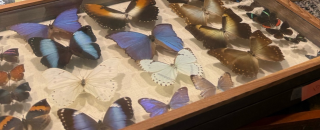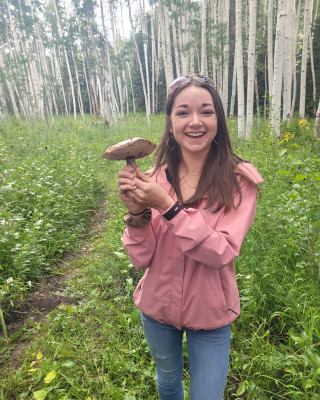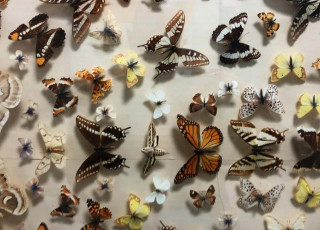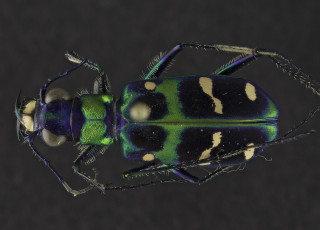Wings of Legacy: The Lasting Impact of George Andrushko
By Cosette Reeves
“Insects test the limits of how odd life on Earth can be,” says NHMU’s Invertebrates Collections Manager Christy Bills. These whimsical critters have fascinated people for centuries — including George Andrushko, a devoted collector who spent decades meticulously preserving his butterfly collection until he passed in 2006.
Soon, NHMU will house this extraordinary collection, ensuring George’s legacy can live on through future scientific endeavors. With its exceptional breadth, condition, and detailed documentation, the Lepidoptera collection is a welcome and valuable addition to the Museum, but beyond its scientific value lies a beautiful story of humanity — of love, memory, and lasting legacy.
At the Heart of Specimen-Based Science
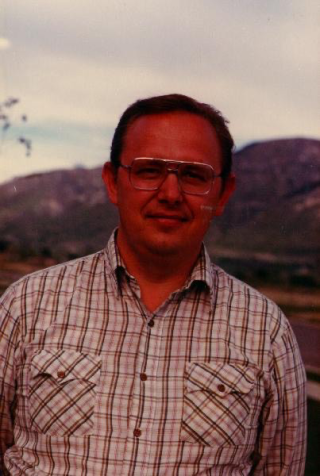
George Andrushko — a loving husband, supportive father, and accomplished amateur insect collector.
Containing over 4,000 specimens, this collection is a significant contribution to science. “Each specimen is like a little book of information,” states Bills — and their value only grows with time. Many of the Museum’s invertebrate specimens were collected before the discovery of DNA, allowing scientists today to extract microscopic details, such as pollen residue, from organisms that lived decades ago. This type of data enables researchers to detect the early entry of invasive species, understand how environmental changes impact local ecosystems and species success, and even explore implications for human health. It makes you wonder what answers these specimens will provide to questions we haven’t even thought to ask yet.
The strides specimen-based research has made would not be possible without amateur insect collectors. According to Fischer et al. (2021), “Amateur butterfly and moth collectors in the United States have procured more Lepidoptera specimens than professional scientists,” and they continue to be a significant source of specimens for natural history museums, building the very foundation of museum entomology collections. “Amateur” may be a misleading term, however, as many of these individuals are indeed experts in their practice — much like George Andrushko.
George Andrushko: A Devoted Collector
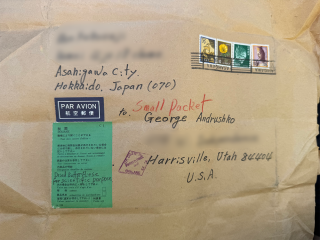
Though he never had the chance to travel beyond the U.S., George connected with lepidopterists around the world to add a handful of international specimens to his collection.
George was an exceptional and dedicated collector. His passion spanned several years, with specimens dating from 1968 to 2002. While the majority of his collection was gathered across Utah, he also acquired international specimens — from Malaysia, Africa, Finland, the Philippines, and Japan — through trades and purchases. A proud member of the Lepidopterists’ Society, George carefully documented and labeled each specimen, using nearly 40 reference books to identify them down to the species. He also crafted his own collecting nets, pinning boards, and storage drawers, and made additional nets for his wife and seven children so they could join him in the field. On his days off, his family often found themselves up in the mountains with nets in hand.
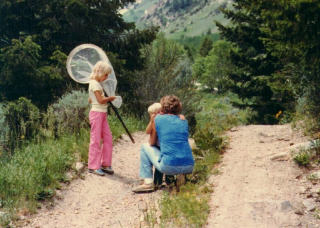
George instilled in his children a deep appreciation for nature, bringing them along on butterfly-collecting trips across Utah — from Snowbasin to Tooele to Strawberry Reservoir.
In a way, that shared time in the field made the collection a family endeavor. After George’s passing, his wife Elaine carried the effort forward, protecting the specimens from pests and environmental damage while they were in storage. Thanks to her ongoing care and George’s precise handling, approximately 80 percent of the collection is viable for future scientific use, while the other 20 percent was carefully pinned by George for display and educational purposes.
The Butterfly Effect
This collection’s breadth and near-mint condition later sparked an unexpected connection — one Elaine Andrushko describes as “heaven-sent.” This serendipitous bond blossomed into a new meaningful friendship, offered the community a way to honor George, and gave Elaine the opportunity to pass the collection into the hands of those who can, and will, carry it forward for generations.
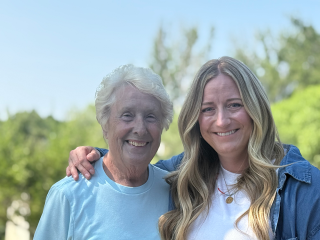
After living near each other for eight years without ever meeting, Elaine (left) and Andrus (right) finally crossed paths at just the right time.
Jena Andrus has been working closely with Elaine to curate this collection for NHMU. Their partnership began by chance in 2023, ignited by a single pinned butterfly. Andrus had brought the specimen to a service auction hosted in Harrisville where it caught Elaine’s eye. As they chatted, Elaine shared the story of George’s extensive butterfly collection. Andrus was captivated. Soon after, Andrus recognized an opportunity: she had just been accepted into the University of Florida’s online master’s program in entomology and needed to find a capstone project — this seemed like the perfect fit. When she discussed this with Elaine and suggested donating the collection to the Museum, Elaine was onboard, eager to see it put to good use. Andrus then connected with Bills, and together, they began formulating a plan to prepare the collection for curation. Once fully curated, it will be digitized and housed at the Museum to support future research projects and educational activities.
What began as an idea for a practical capstone project quickly became something far more personal and resonating. When Andrus went to Elaine’s home to view the collection for the first time, she describes it as an emotional experience. The man whose hands so lovingly handled these stunning specimens was also a kind and supportive husband and father — a man who deserves to be recognized not only for his accomplishments but also for simply who he was and how he treated those around him. “There’s a human side to science — there are people behind the lens, behind the microscope. It makes me look at specimens a bit differently,” Andrus remarks. Although science is methodical in nature, humanity is the driver. Without the curiosity and wonder of individuals like George, we would not be where we are today.
Love and Legacy
Humble, gracious, creative, and with a great sense of humor, George was a remarkable human being and companion. “We were the best team,” says Elaine, “we complemented each other well — he completed me.”

“I just get to be a part of the greatest love story ever told.” – Andrus
They met here in Utah at a USO dance at Hill Air Force Base, where George was stationed during his four-year term in the military. Upon meeting Elaine, with live music playing cheerfully in the background, he asked, “What’s a girl like you doing in a place like this?” Elaine simply replied, “Dancing!” — a fitting, if slightly cheeky, response as USO dances were a beloved venue at the time for singles to meet new people. This charming first encounter — almost like something out of a movie — sparked a lifetime of love, joy, and support. Andrus views this collection as a testament to that love. It stands not only as a legacy of science but as evidence to the deep bond George and Elaine shared and the life they built together around their passions.
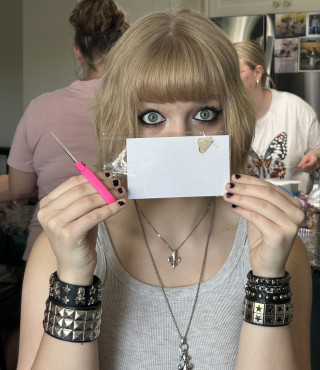
Throughout May, Andrus has organized two volunteer events in Harrisville, during which volunteers, including the one you see here, have helped sort and organize over 1,000 specimens.
For Elaine, seeing this collection put to good use is a blessing. She often sheds tears of joy as she recalls memories with her sweetheart George and watches his passion come to fruition once again. United by this heartfelt sentiment — and a shared fascination with insects — the Harrisville community is joining in. Andrus is organizing a series of events for the community to help assess and transfer the specimens into glassine, museum-quality envelopes, which will maintain their scientific integrity for years to come. In a time when so much can feel divided, this community is coming together — honoring George’s legacy and celebrating the beautiful creations of the natural world.
NHMU is honored to accept Elaine’s donation and is deeply grateful for Andrus’s efforts in its curation.
